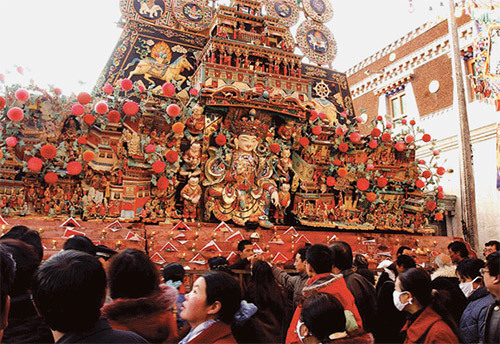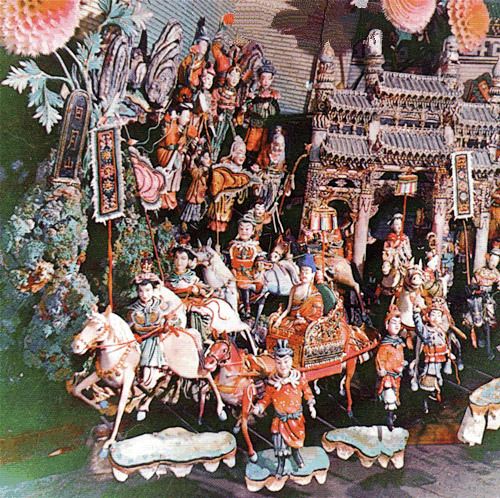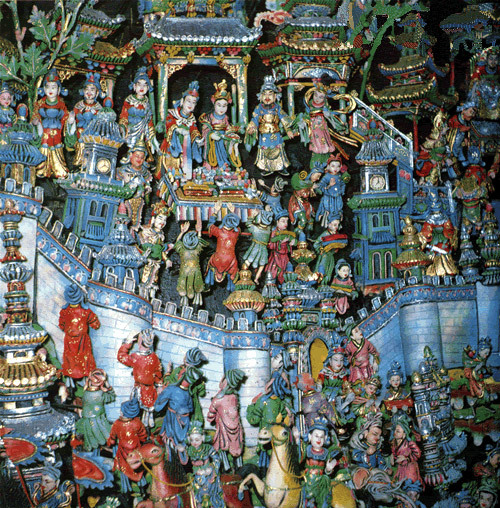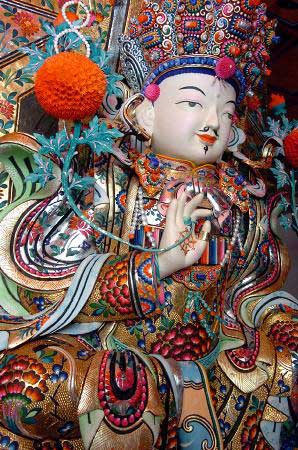Hello, welcome to the official website of Yunnan Shangri-La Balagezong Tourism Development Co., Ltd!

02
2015
-
12
Butter Flower
作者:
Butter flower is one of the three artistic wonders of Ta'er Monastery, the holy land of Tibetan Buddhism in China. As an oil-plastic art, butter flower is a variety of Buddha statues, figures, landscapes, birds and animals, trees and flowers, pavilions and pavilions carefully shaped by art monks in the cold winter season. Its works are lifelike, colorful and exquisite. During the Lantern Festival, the Ta'er Temple will exhibit the butter flower works collectively made by the flower monks, attracting many domestic and foreign tourists to visit.

The ghee flower, known as one of the three great arts of the Taer Monastery, attracts many domestic and foreign visitors every year for its exquisite craftsmanship. The themes of this year's ghee flower exhibition made by the artists and monks of the upper and lower houses are the story of Shambhala and the story of Mira Riba.

Princess Wencheng Pathway Riyueshan

Princess Wencheng's Entry into Tibet
Butter flower is a unique art of ghee shaping in Tibetan culture. It was first produced in Tibet.
The origin of butter flower

In 641 AD, the Tang Dynasty married Tubo. When Princess Wencheng was welcomed to Lhasa, she brought a 12-year-old statue of Shiying Muni. Later, the Buddha statue was enshrined in the Jokhang Temple. The Tibetan people paid tribute in front of the Buddha statue. According to the traditional Buddhist customs of India. The tributes dedicated to Buddha and Bodhisattva are of six colors, namely flowers, painted incense, holy water, tile incense, fruit and Buddha lamp. But at that time, when the grass was withered and flowers were dead, they could not pick flowers, so they had to throw ghee and shape a bunch of flowers for the Buddha. Butter flower is a kind of oil plastic crafts, with butter as the main raw material. Ghee is a kind of cream food for Tibetan herders such as Qinghai-Tibet Plateau. It is a yellow-white oil made by repeatedly stirring milk. This kind of oil is solidified, soft and delicate color pure fragrance, plasticity is extremely strong. The handicrafts it creates have the characteristics of vivid image, bright color, exquisite and exquisite. According to legend, Master Tsongkhapa had a strange dream one night, in which thorns turned into lanterns, weeds turned into flowers, and countless treasures, colorful and dazzling. After waking up, in order to reproduce the wonderful dream, he immediately organized art monks to use ghee to shape various flowers, trees and treasures. Together with countless butter lamps dedicated to the Buddha.
The art of pastry and the Fifteen Lantern Festival have been spread to the Kumbum Monastery, the birthplace of the Gelug Sect, for hundreds of years. At first, the content of butter flowers was monotonous and the production was rough. Later, two butter flower houses were established successively to cultivate pastry monks. The art monks of the upper and lower flower houses, with their sincerity to the Buddha and their persistent pursuit of art, learn from each other in various aspects of oil sculpture skills, learn from each other's strengths to make up for their weaknesses, and renovate their samples year after year, with their content and themes constantly changing. The skill is becoming more and more exquisite. It even surpassed some temples in Tibet, the birthplace of butter flowers, and was recognized as a must by the society.
Production Process of Butter Flower
The shaping process of butter flowers is extremely complex and unique, and it is mostly carried out during the three months of winter. To make the ghee more smooth and delicate. Remove the impurities and shape it more handy. Soak the ghee in cold water for a long time and knead it into a paste for later use. Before shaping, the oil-plastic monk must first bathe and make a vow and perform a religious ceremony. After the ceremony, Zhang Chi and other art monks selected the theme of butter flowers and then designed the abdominal draft carefully conceived, planned and laid out. They were assigned to masters who were good at people, animals, flowers and architecture to lead their apprentices and began to work separately in a cool room with a temperature below zero. The first is to tie up the basic skeleton. According to the content of the proposed subject matter carefully designed, with soft leather bundles, hemp rope, bamboo cups and sticks and other things tied into large and small different forms of the "skeleton", that is, the shape of the basic model. The second is shape. The first raw material for shaping is to use the old butter flower removed last year and the wheat straw ash to smash into hard and elastic black shaped sludge with a rod. This black sludge is used to shape different bodies on the skeleton, and its plastic method is similar to surface plastic or clay plastic. After the basic shape is completed, the shape posture, size and mutual overall structure proportion shall be modified and approved by the palm ruler before finalization. The second ingredient is to knead a variety of mineral pigments into a cream-colored cream butter. It is mixed into colorful pastry raw materials, carefully coated and molded on the finished body, and some are also outlined with gold and silver powder to complete the shaping of various images. If you create red flowers and green leaves or exquisite jade and jade to play with, you will directly use colored oil to make it once. Finally will shape a good butter flower according to the overall requirements of the design. Install in place with wire one by one. Fixed on several large boards or in special pots. The layout is a single flower figure or a whole story picture, commonly known as "ghee flower stand".
Butter flower rich subject matter
Butter flowers show various artistic forms and a wide range of subjects, mostly Buddhist stories, historical stories, biographies, flowers and trees, birds and animals, Buddha statues and characters. With the passage of the times, and constantly give some new flavor of the times. For example, "The Story of Shiying Muni's Life" not only enriches the traditional style of butter flowers, but also vividly reflects real life, making the previous single-plastic technique gradually develop into a combination of vertical and floating plastics, single and group plastics, and flower stands and pots. The Taer Monastery has a buttered flower pavilion dedicated to the art of oil and plastic.
最新动态
2022-08-23
The current outbreak, the responsibility is on the shoulder, Balagzon in action!
Since the outbreak of the epidemic in Tibet on August 7, 2022, a large number of tourists from Tibet to Yunnan have entered Shangri-La from National Highway 214. The People's Government of Diqing Prefecture has issued a series of relevant policies and measures and actively responded. Medical staff, police and other front-line personnel stick to the front line, have been involved in the "war of resistance" of the epidemic without gunpowder smoke, and jointly participate in dealing with a major public health security incident faced by mankind.



